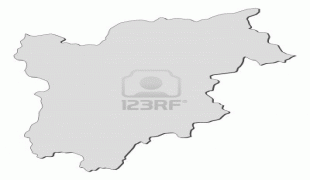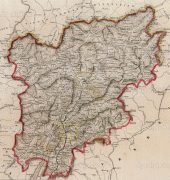Trentino-Alto Adige (Trentino-Alto Adige)
 |
 |
From the 9th century until 1801, the region was part of the Holy Roman Empire. After being part of the short-lived Napoleonic Republic of Italy and Napoleonic Kingdom of Italy, the region was part of the Austrian Empire and its successor Austria-Hungary from 1815 until its 1919 transfer to Italy in the Treaty of Saint-Germain-en-Laye at the end of World War I. Together with the Austrian state of Tyrol, it is part of the Euroregion Tyrol-South Tyrol-Trentino.
In English language, the region is known as Trentino-South Tyrol or by its Italian name Trentino-Alto Adige.
The Romans conquered the region in 15 BC. After the end of the Western Roman Empire, it was divided between the invading Germanic tribes in the Lombard Duchy of Tridentum (today's Trentino), the Alamannic Vinschgau, and the Bavarians (who took the remaining part). After the creation of the Kingdom of Italy under Charlemagne, the Marquisate of Verona included the areas south of Bolzano, while the Duchy of Bavaria received the remaining part.
From the 11th century onwards, part of the region was governed by the prince-bishops of Trent and Brixen, to whom the Holy Roman Emperors had given extensive temporal powers over their bishoprics. Soon, they were overruled by the Counts of Tyrol and Counts of Görz, who also controlled the Puster Valley: in 1363 its last titular, Margarete, Countess of Tyrol ceded the region to the House of Habsburg. The regions north of Salorno were largely Germanized in the early Middle Ages, and important German poets like Arbeo of Freising and Oswald von Wolkenstein were born and lived in the southern part of Tyrol.
The two bishoprics were secularized by the Treaty of Lunéville of 1803 and given to the Habsburgs. Two years later, following the Austrian defeat at Austerlitz, the region was given to Napoleon's ally Bavaria (Treaty of Pressburg, 1805). The new rulers provoked a popular rebellion in 1809, led by Andreas Hofer, a landlord from St. Leonhard in Passeier; this rebellion was crushed the same year. At the resulting Treaty of Paris (28 February 1810), Bavaria ceded the southern part of Tyrol (Trentino and the city of Bolzano) to the Napoleonic Kingdom of Italy. During French control of the region, it was called officially Haut Adige (literally "High Adige", Italian: "Alto Adige"; German: "Hochetsch") in order to avoid any reference to the historical County of Tyrol. After Napoleon's defeat, in 1815, the region returned to Austria.
Under Austrian rule the territory of today's province of South Tyrol was called südliches Tirol or Deutschsüdtirol, but was occasionally also referred to as Mitteltirol, i.e. Middle Tyrol, due to its geographic position, while Südtirol (Tirolo meridionale), i.e. South Tyrol, indicated mostly today's province of Trentino. Trentino was also called Welschtirol ("Romance Tyrol", Tirolo italiano) or Welschsüdtirol ("Romance South Tyrol", Tirolo meridionale italiano). Sometimes Südtirol also indicated the whole of the Trentino-Alto Adige/Südtirol region.
During the First World War, major battles were fought high in the Alps and Dolomites between Austro-Hungarian Kaiserjäger and Italian Alpini, for whom control of the region was a key strategic objective. The collapse of the Austro-Hungarian war effort enabled Italian troops to occupy the region in 1918 and its annexation was confirmed in the post-war treaties, which awarded the region to Italy under the terms of the Treaty of Saint-Germain.
Under the dictatorship of Benito Mussolini, the Fascist dictator of Italy (ruled 1922–1943), the German population was subjected to an increased forced programme of Italianization: all references to old Tyrol were banned and the region was referred to as Venezia Tridentina between 1919 and 1947, in an attempt to justify the Italian claims to the area by historically linking the region to one of the Roman Regions of Italy (Regio X Venetia et Histria). Hitler and Mussolini agreed in 1938 that the German-speaking population would be transferred to German-ruled territory or dispersed around Italy, but the outbreak of the Second World War prevented them from fully carrying out the relocation. Nevertheless, thousands of people were relocated to Nazi Germany and only with great difficulties managed to return to their ancestral land after the end of the war.
In 1943, when the Italian government signed an armistice with the Allies, the region was occupied by Germany, which reorganised it as the Operation Zone of the Alpine Foothills and put it under the administration of Gauleiter Franz Hofer. The region was de facto annexed to the German Reich (with the addition of the province of Belluno) until the end of the war. This status ended along with the Nazi regime and Italian rule was restored in 1945.
Map - Trentino-Alto Adige (Trentino-Alto Adige)
Map
Country - Italy
 |
 |
| Flag of Italy | |
Italy was the native place of many civilizations such as the Italic peoples and the Etruscans, while due to its central geographic location in Southern Europe and the Mediterranean, the country has also historically been home to myriad peoples and cultures, who immigrated to the peninsula throughout history. The Latins, native of central Italy, formed the Roman Kingdom in the 8th century BC, which eventually became a republic with a government of the Senate and the People. The Roman Republic initially conquered and assimilated its neighbours on the Italian peninsula, eventually expanding and conquering a large part of Europe, North Africa and Western Asia. By the first century BC, the Roman Empire emerged as the dominant power in the Mediterranean Basin and became a leading cultural, political and religious centre, inaugurating the Pax Romana, a period of more than 200 years during which Italy's law, technology, economy, art, and literature developed.
Currency / Language
| ISO | Currency | Symbol | Significant figures |
|---|---|---|---|
| EUR | Euro | € | 2 |
| ISO | Language |
|---|---|
| CA | Catalan language |
| CO | Corsican language |
| FR | French language |
| DE | German language |
| IT | Italian language |
| SC | Sardinian language |
| SL | Slovene language |



























